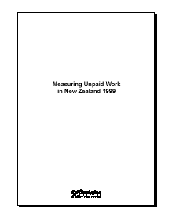

- BUDGET 2001
The Jobs Letter editors summarise Budget 2001 initiatives
- BENEFICIARIES RISE DESPITE FALLING UNEMPLOYMENT
Budget figures show that there are now more welfare beneficiaries than when unemployment reached its peak a decade ago, and numbers are predicted to keep rising. Despite the fact that unemployment is falling with 352,000 more people in paid work now compared to 1991, there are 63,000 more beneficiaries of working age than then.Unemployment peaked at 10.9% of the workforce in 1991, but the official figures have halved since then. But figures in the Budget predict that there will be 25,000 more working-age beneficiaries by 2005, taking the total to 382,000.
- The Dominion points out that the cost of welfare is also rising after being contained for some years by the 1991 benefit cuts and the raising of the age of eligibility for superannuation from 60 to 65.
Ten years ago, all benefits, including superannuation, took $10.1 billion of $31.2 billion in government spending. While all government income and spending is forecast to rise, the government is expecting to continue to spend about a third of its expenditure on welfare. This financial year, benefits are expected to take $12.9 billion of total spending of $39.4 billion. By 2005, benefits are predicted to take $14.2 billion of total spending of $42.8 billion.
• Budget tables predict that the unemployment rate will fall to 5.1% by 2005. Treasury predictions for the years 2006-2011 put the unemployment rate at 5.9%. Their "scenarios" for 2006-2051 put the rate at 6%.
Source — The Dominion 4 June 2001 "More beneficiaries than at unemployment peak" by David McLoughlin
GROWING BENEFICIARY NUMBERS Benefit Type 1991 2001 2005 (forecast) Domestic Purposes 97,000 110,000 112,000 Unemployment 147,000 155,000 162,000 Invalids 29,000 58,000 72,000 Sickness 21,000 34,000 36,000 Total Working Age
Beneficiaries294,000 357,000 382,000 NZ Superannuation 500,000 449,000 473,000 Total Beneficiaries 794,000 806,000 855,000 Unemployment Rate 10.9% 5.4% 5.1% Source — Treasury, Budget Tables, The Dominion
- BUDGET INITIATIVES FOR "WALL OF WOOD"
The Budget has announced initiatives aimed at harvesting the East Coast's "wall of wood" and addressing the local labour shortages in the forestry sector. Labour and skill shortages were seen as a major issue by the Tairawhiti Development Taskforce last year, mindful that the number of logs coming on-stream will double during the next decade. Industry leaders describe the labour shortages as "disastrous" now, and warn that companies will have to bring in skilled workers from overseas.A Labour Department report for the Wood Processing Strategy Group says that the labour pool in the region is surprisingly small, and there is a lack of incentives to encourage people to work in the industry. The report identifies issues such as a lack of work skills and discipline, alcohol and drug use, low pay in the industry, and people opting for benefits and seasonal work rather than forestry careers.
The Budget has allocated a package totalling $700,000 to begin to address these issues. $120,000 will go towards employing a full-time co-ordinator for 12 months to bring together the government, industry and community efforts in the area. In the pipeline are: literacy, numeracy and silviculture training programmes to prepare job seekers for forestry jobs, working with contractors on how to be good employers, and resourcing local social service providers to work with local problems, including substance abuse.
Source _ Newsroom 25 May 2001 "Govt moves on forestry labour shortage" by Patric Lane; Newsroom 25 May 2001 "Labour shortage to harvest logs" by Frank Perry; Maharey Notes 23 May 2001 "Harvesting Tairawhiti's wall-of-wood"
- UNPAID WORK VALUED AT $40M
The value of productive unpaid work by New Zealanders aged 15 years and over was estimated at $40 billion in 1999, according to a report released last month by Statistics NZ. This is equivalent to 39%of gross domestic product (GDP).The report estimates the value of productive unpaid work that falls outside the measures of production found in the national accounts. It is based on the recently-released Time Use Survey which collected data on how New Zealanders spend their time. This information has been combined with a median housekeeper wage rate to derive the unpaid work values. The report follows similar studies recently done overseas and the choice of method used to define and value unpaid work is consistent with an emerging international consensus. The report shows:
— persons aged 15 and over spend, on average, four more hours per week in unpaid work (27.6 hours per week) than in paid work (23.6 hours per week);
— 87% of the estimated value of unpaid work was on activities such as cooking, cleaning, gardening and providing care, which were for the benefit of the same household;
— the remaining 13% of unpaid work was done for other households or for the community;
— NZ'ers devote 247 million hours per year to unpaid volunteer work for community organisations, with an estimated value of $2 billion;
— if paid for this work ( at a median housekeeper wage rate) the average person would receive the equivalent of $13,820 per year;
— work done by women accounted for 64% of the total value of unpaid work ($25 billion);
—work done by Maori accounted for 13% of the total value of unpaid work ($5 billion). This is similar to the proportion of Maori to the total population aged 15 and over.

Measuring Unpaid Work in New Zealand 1999,
by Statistics New Zealand
can be ordered by email at publications@stats.govt.nz, or can be downloaded from their website at www.stats.govt.nz.
 Full document
Full document
(72 pg, 3 MB)
Source _ Measuring Unpaid Work in New Zealand 1999, by Statistics New Zealand; Press Release: Statistics NZ 25 May 2001 "Unpaid work valued at $40 billion in 1999"; The Dominion 16 May 2001 "Plunket boss lauds volunteer workers" by Lidsey Birnie
- VALUING THE VOLUNTEERS TOO
Plunket Society's national president Pam Murray is critical of the "minimal acknowledgement" of the contribution of volunteers in this country, even during this International Year of the Volunteer. Murray argues that NZ's social infrastructure would fall apart if volunteers withdrew their services: "There would be no meals on wheels delivery, no school trips, no remedial reading in schools, no lives saved at beaches and no drivers for cancer treatment patients — the list is never-ending..."The value of volunteering is clearly evident to Plunket, which provides Well Child services to children and young parents. A visiting professor from Georgetown University has estimated the value of the 8,000 Plunket volunteers at about $46.8 million. The volunteers also raise more than $5 million each year to bridge the gap between government funding and what is required to deliver their services.
Source — The Dominion 16 May 2001 "Plunket boss lauds volunteer workers" by Lindsey Birnie
- BUSINESSES POINT TO SKILL SHORTAGES
The latest NZ Institute of Economic Research (NZIER) quarterly survey of business opinion shows a net 44% of businesses are finding it difficult to get skilled labour, and a net 11% say that unskilled labour is hard to find. This is the highest reading since 1995, when the economy was growing at 4%, and New Zealand Herald financial writer Craig Howie says this suggests that any pick-up in the economy would aggravate the skills shortage problem.BNZ Chief economist Tony Alexander comments the survey has several implications for the economy: employment costs would escalate; work standards may deteriorate when workers realise there are more jobs out there; labour turnover would accelerate, imposing added staff training costs; and businesses will put extra investment in labour savings technology.
Alexander: "Since the late 1960s and early 1970s in NZ, the balance of power had been in favour of the employer. But three or four years ago, we started to see that changing with skill shortages in some areas such as accounting and legal work. It's now much more widespread..."
Source — NZ Herald 16 April 2001 "Skills shortage grows critical" by Ellen Read;
- TOURISM STRATEGY
A national tourism strategy has been released which sets aggressive performance targets for the sector, and a range of challenges for industry leaders, tourism operators and politicians. If its recommendations are adopted, it says the tourism sector could provide an extra 100,000 jobs in the next ten years — and more than a fifth of them could be expected to be amongst Maori.The strategy forecasts spending by overseas tourists will jump to $9.4 billion by 2010. It highlights the need to help tourists who come here to spend more, rather than simply aiming to boost tourist numbers. Example: a 1% increase in tourist spending brings the same economic benefit — $1 billion more revenue — as a 12% growth in tourist numbers.
- The strategy warns that its growth plan could easily stumble because of skill shortages in this country. And it is blunt in its assessment of the existing skills and training frameworks facing the tourism sector. The report: "People are the key to the success of NZ tourism, but at present there is no process for identifying current and future workforce needs and aligning tourism training to meet those needs..."
The report argues that tourism's share of industry training is disproportionately low when compared to its contribution to the economy. It says that Skill NZ has not seen tourism as a priority area for training. Last year it allocated just 1.1% of funding for industry training to aviation, tourism, travel and hospitality, compared with 10.1% for agriculture and 9.1% for forestry.
The report also comments that the renumeration structure and perceptions about low skill level, low status, lack of career paths and seasonality of many jobs have all resulted in tourism not being seen as an attractive long-term prospect for employment.
— The Tourism 2010 report can be downloaded from the Tourism NZ website at www.tourisminfo.govt.nz
Source — The Dominion 30 May 2001 "Tourism growth plan could stumble on skills shortage" by Craig Howie; New Zealand Herald 18 May 2001 "Tourism Industry shakeup could treble income, says plan" by Simon Hendry
- CATCHING THE KNOWLEDGE WAVE

The Catching the Knowledge Wave conference is aimed at transforming NZ into a high-technology, "upmarket" economy. PM Helen Clark says the conference would build on themes of innovation and the knowledge society. Key speakers will be Sean Dorgan, CEO of the Industry Development Agency behind the "jobs machine" in Ireland, and George Yeo, Singapore's Minister of Trade and Industry. Economic case studies from overseas will be presented to over 450 politicians, senior bureaucrats, academics, business leaders, trade workers and community leaders.The conference will be run in August and is a joint effort between the government and Auckland University. For more information contact www.knowledgewave.org.nz
Source — NZ Herald 31 May 2001 "Think tank on new economy"

Top of Page
This Letter's Main Page
Stats | Subscribe | Index |
The Jobs Letter Home Page | The Website Home Page
jrt@jobsletter.org.nz
The Jobs Research Trust -- a not-for-profit Charitable Trust
constituted in 1994
We publish The Jobs Letter - BENEFICIARIES RISE DESPITE FALLING UNEMPLOYMENT

Essential Information on an Essential Issue

Letter No.146
8 June 2001











